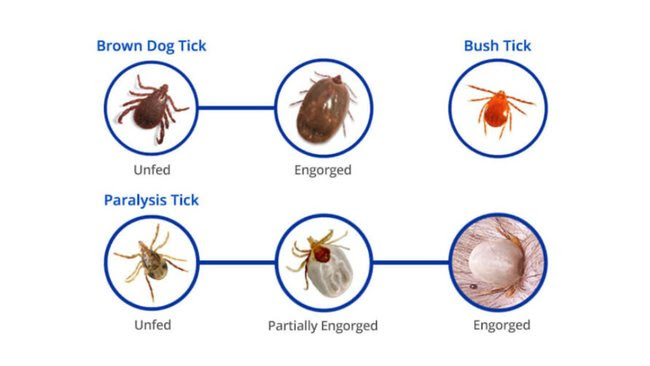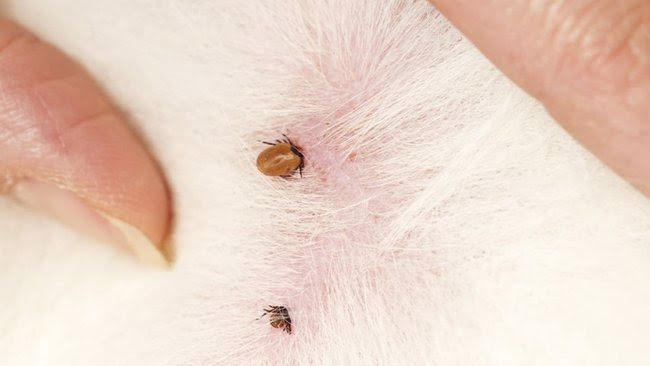It’s Tick Season Again
Luckily for local residents, we don’t have them here, however, if you travel to the coast, they are a serious problem and every year, countless animals die because of them. So, if you are planning on taking your furry friend with you on a holiday please keep reading to learn how to keep them safe and potentially save yourself a lot of money and heartbreak.
Paralysis ticks are blood-sucking parasites which live in scrub, long grass and back gardens all along the East Coast of Australia, from far north Queensland all the way down to Victoria. They attach themselves to animals and release a neurotoxin, which can quickly lead to serious illness, paralysis and even possibly death if left untreated.
Ticks vary in colour and size, from 1mm to 10mm long and from almost white to light brown to a grey/blue. Their body becomes bigger and darker as they feed on blood. All ticks can carry diseases, but in our area, it is the Paralysis tick that we see causes the most harm.

Common ticks found across Australia vary in size and appearance but all pose a risk to pets. This graphic shows how ticks look before feeding and how they swell after drawing blood, increasing the danger of tick paralysis. Credit: Nexguard
There has been a large number of Paralysis tick cases in the last few weeks and it is likely that the sudden spike is being fuelled by unseasonably warm weather combined with a drop in pet owners using preventatives over winter.

Ticks latch onto cats and dogs, feeding on their blood and releasing toxins that can cause serious paralysis if not treated quickly. Credit: Sashvet/Four Paws
Once paralysis occurs, the animal is likely to die unless treated quickly with tick anti-serum and supportive treatment administered by a vet. Full recovery can take weeks and treating tick paralysis can potentially cost thousands of dollars as it often involves intensive care, anti-serum, and even mechanical ventilation in severe cases where the animal is developing respiratory failure.
Prevention is so easy and so much better and cheaper than cure so always ensuring your dog or cat is consistently up-to-date with their tick prevention medication is imperative if you plan on travelling to the coast. These preventative options — including tick collars, oral medications and spot-on treatments typically cost less than $100 for several months’ coverage so we really encourage all pet owners to visit their local vet clinic or pet shop for advice on how best to protect their pets. The cost of prevention is minor compared with the expense and heartbreak of tick paralysis treatment.

Ticks are small parasites that latch onto pets to feed on their blood, often hiding in bushy or grassy areas across Australia. Credit: Nexguard
It’s also important to be aware that ticks may still attach to your dog or cat even if you have treated them. Luckily though, the tick should die and drop off before it has a chance to inject to much toxin. It is however still very important to be aware of the early signs of tick paralysis, so you can seek veterinary attention quickly if needed. Remember that when the tick first attaches, there are often no visible symptoms, so if you can find and remove it before enough toxin is injected, you can potentially prevent paralysis altogether.
Signs to look out for can include:
- Change in the sound of their bark
- Difficulty going up stairs
- Vomiting or dry retching
- Lethargy
- Loss of appetite
- Excessive salivating
- Coughing or loud panting
- Wobbly gait
- Weakness in the hind limbs, which may progress to total paralysis
Ticks are commonly found in bushland and scrubby areas so avoiding these habitats where possible can also reduce the risk.
How to remove a tick safely
We recommend removing ticks as soon as possible using a tick removal tool or fine-tipped tweezers.
- Grip the tick close to the skin and twist or pull gently.
- Do not squeeze or leave the head behind as this can cause infection and allow toxins to enter.
- Tick removal tools are available at vets and pet stores. If you are unsure, come in and ask our friendly staff for help.
- Never burn or smother ticks.
- If you find a tick or notice symptoms, seek veterinary care immediately.
- When removing a tick yourself, keep the tick and take it with you to the clinic for identification.
And finally, if you’re planning a trip to the coast and would like to learn more about tick prevention, make an appointment to come in and see us so we can get your pet started on the most appropriate preventative so you can all have a safe and happy holiday.

